
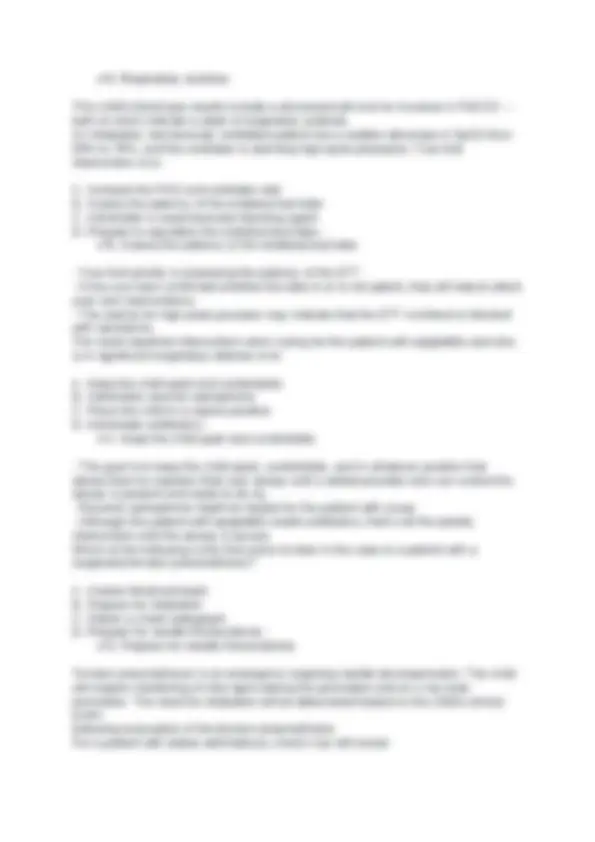
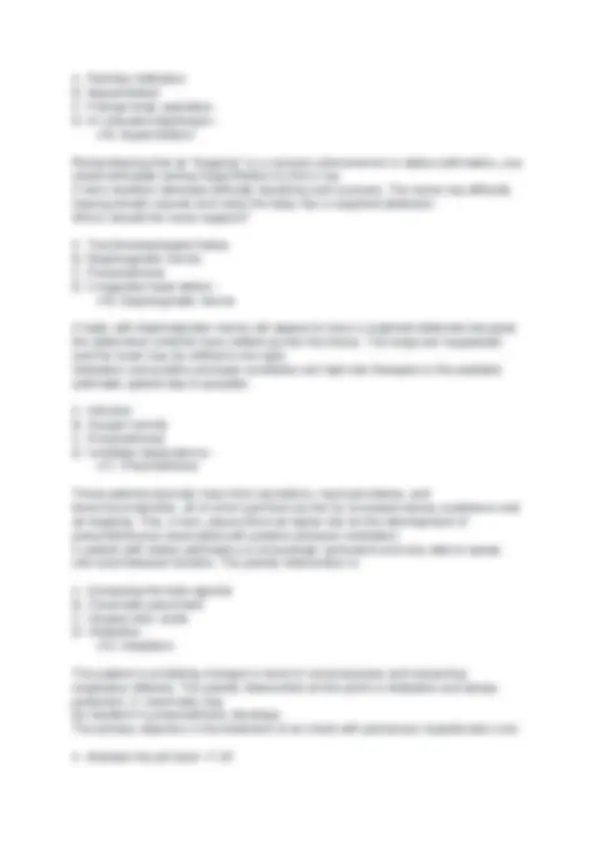
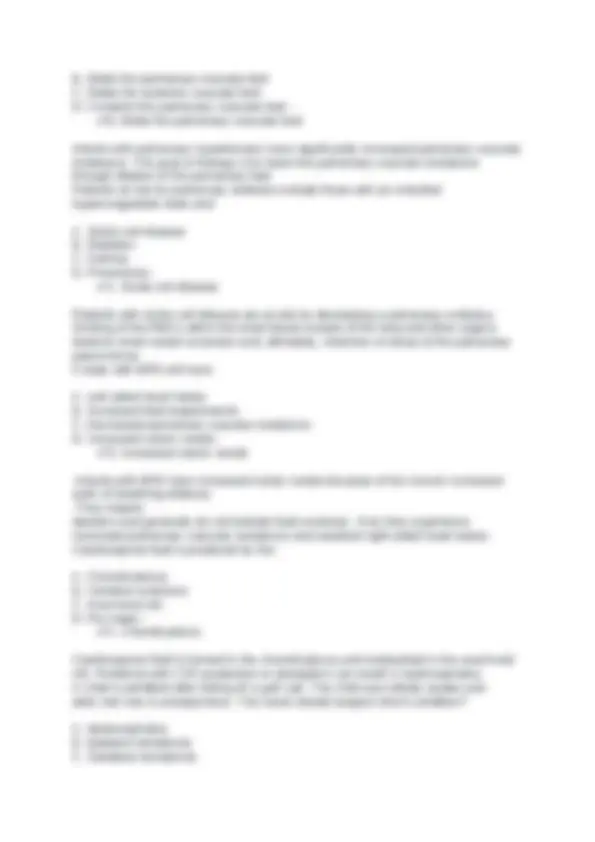
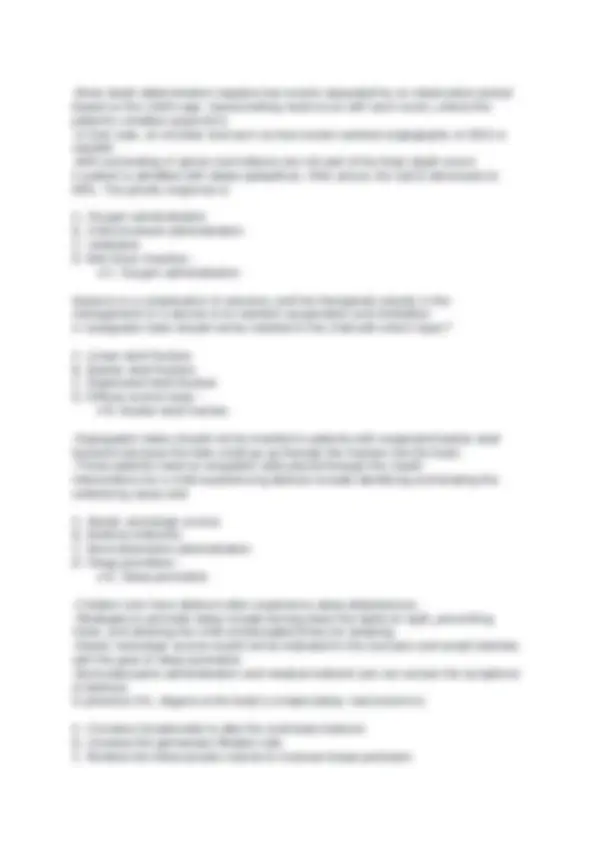
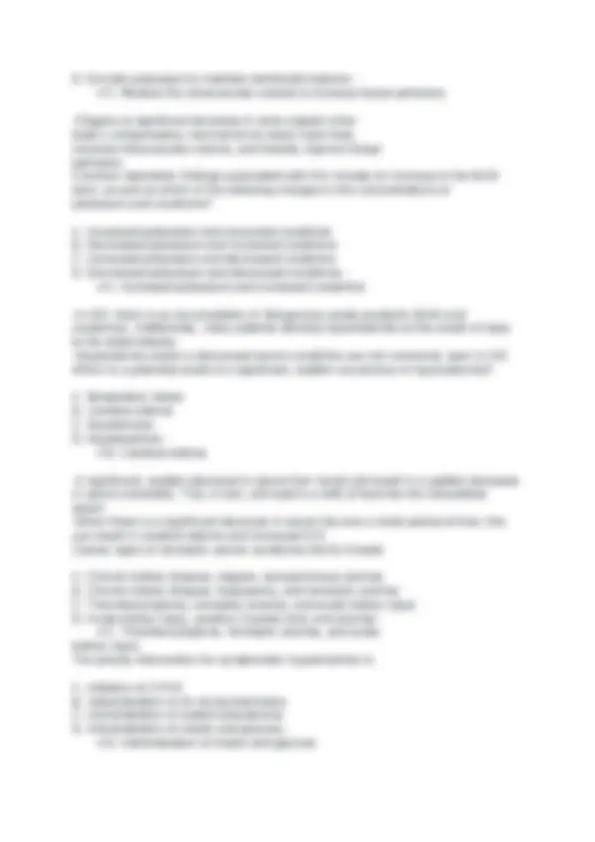
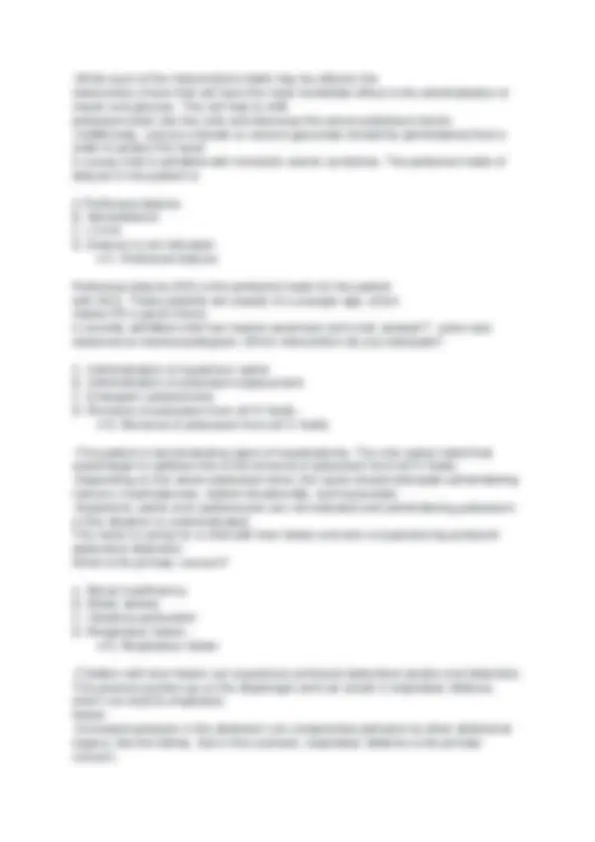
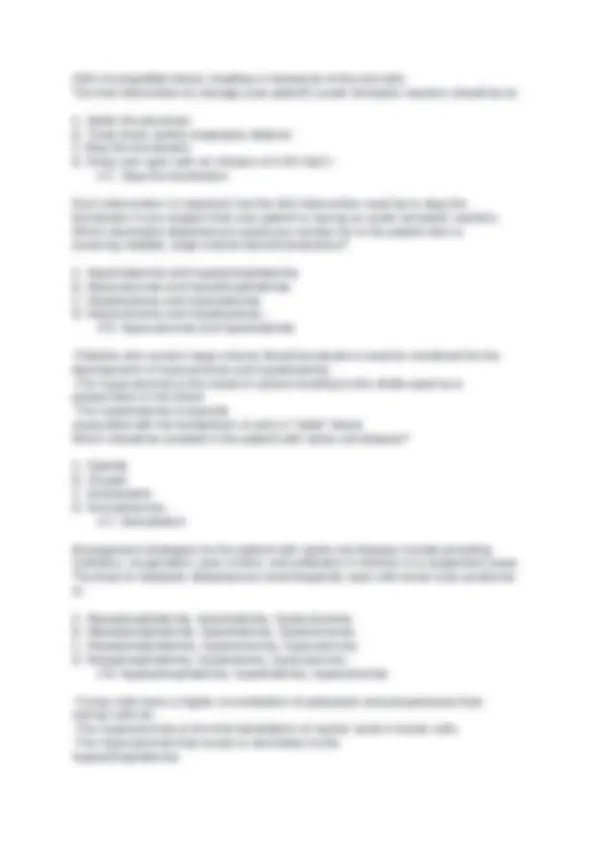
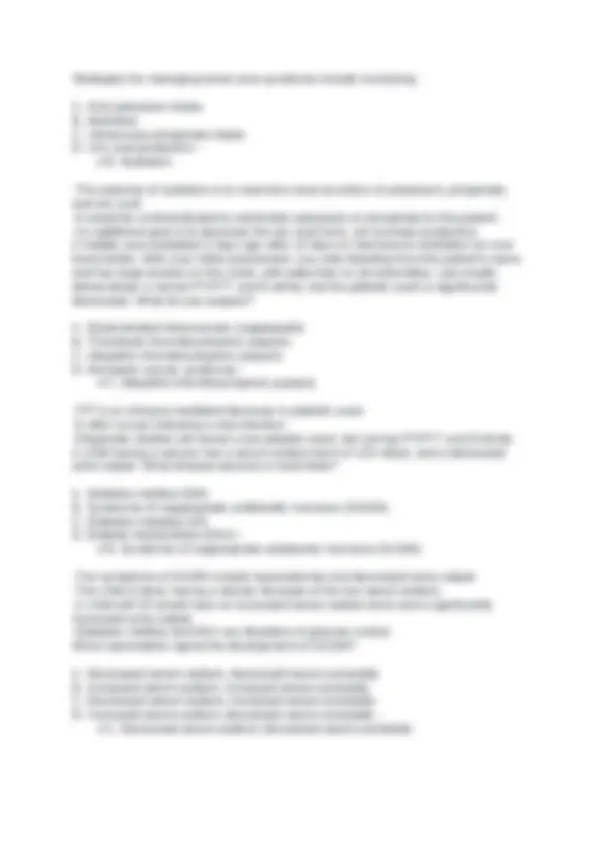
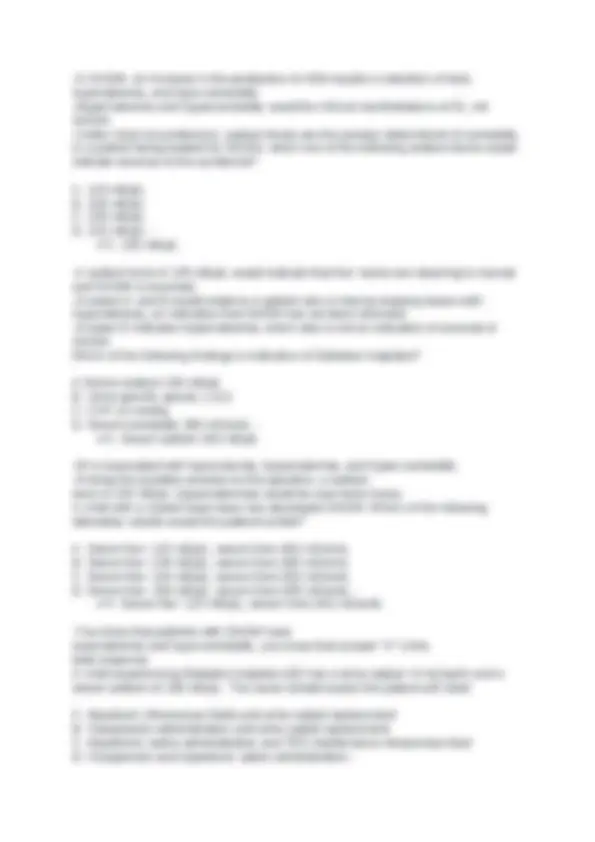
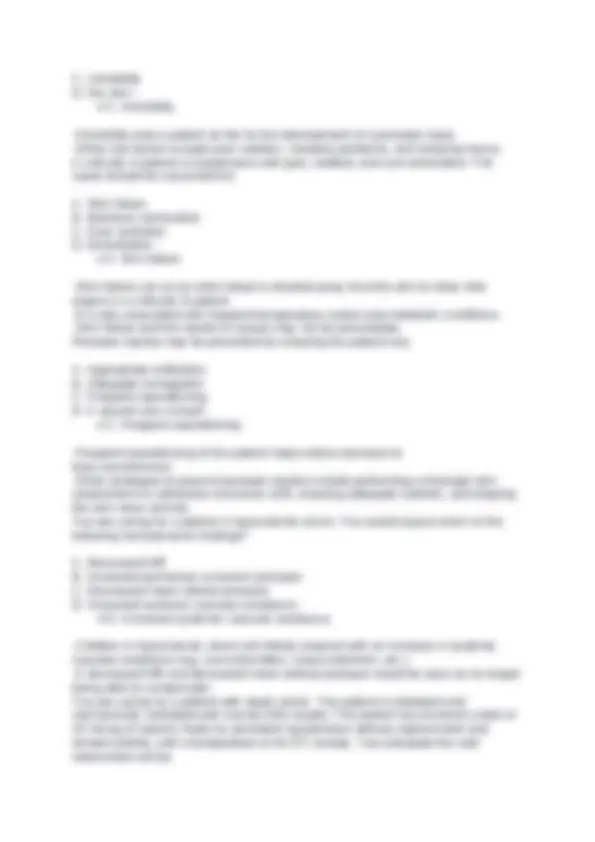
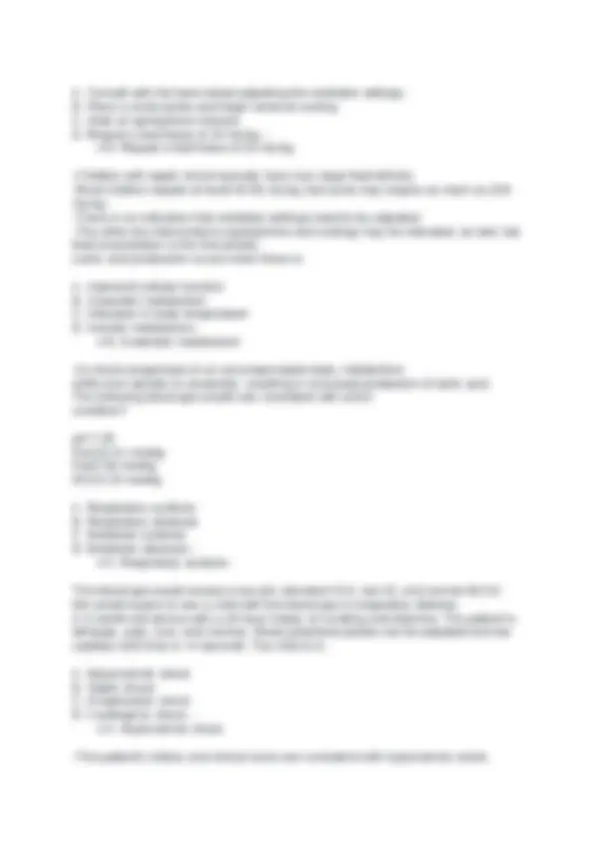
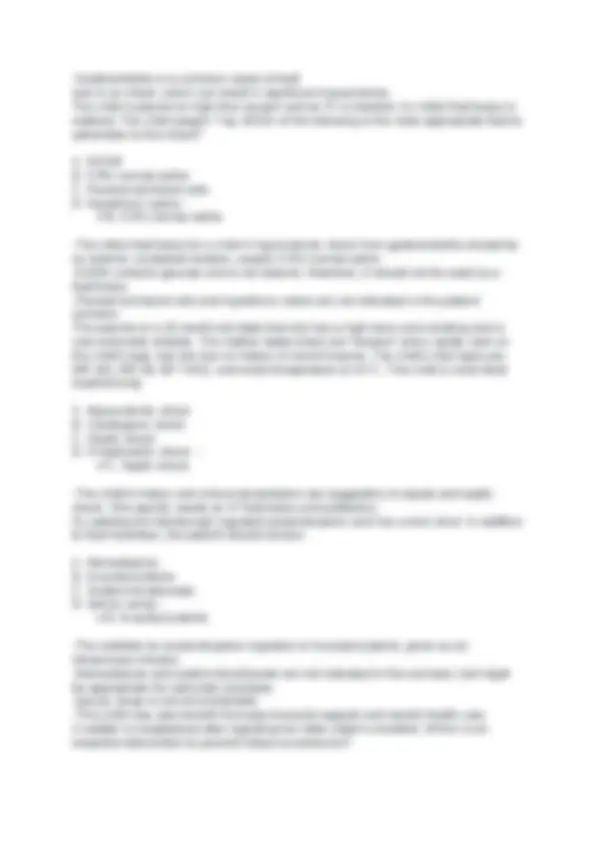
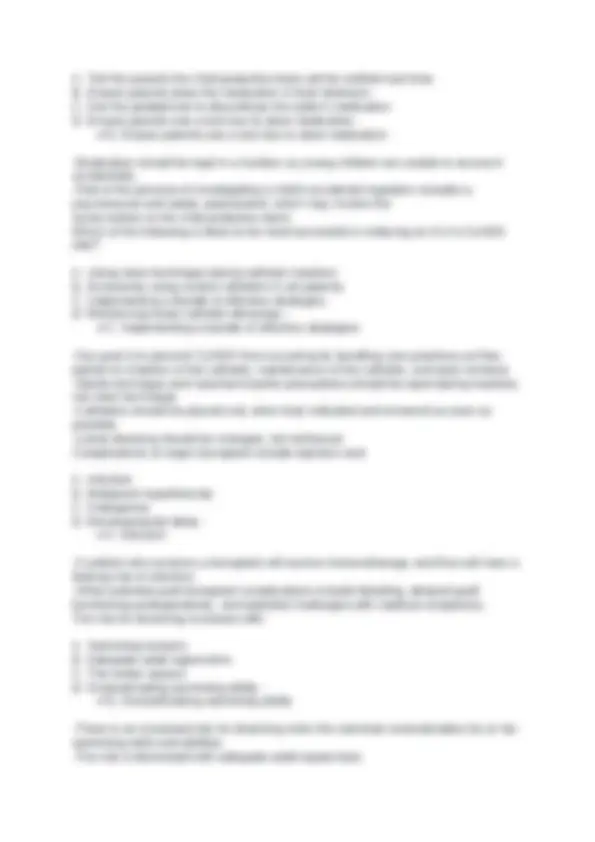
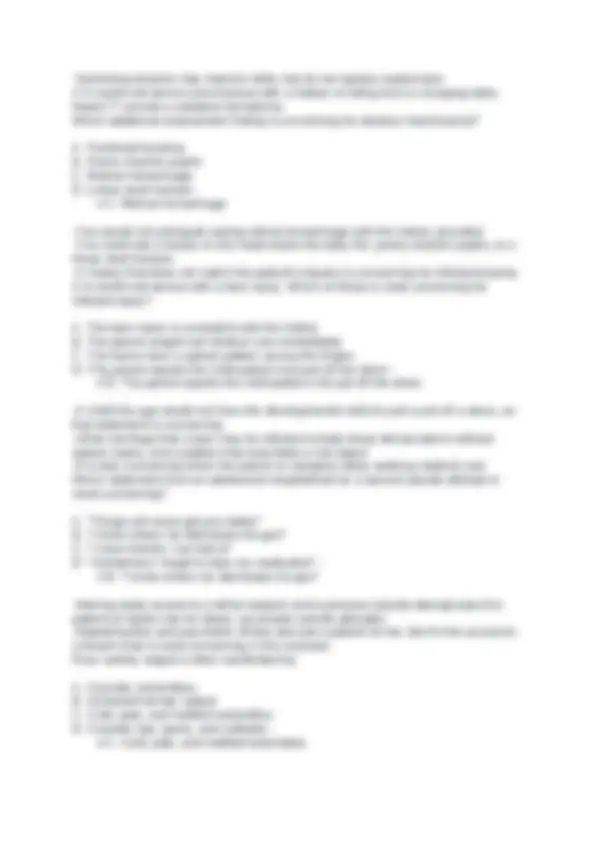
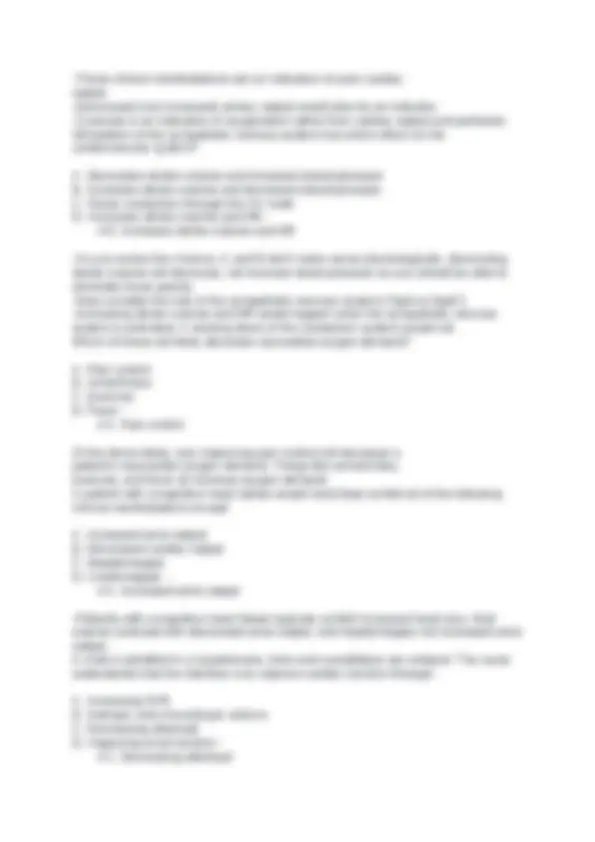


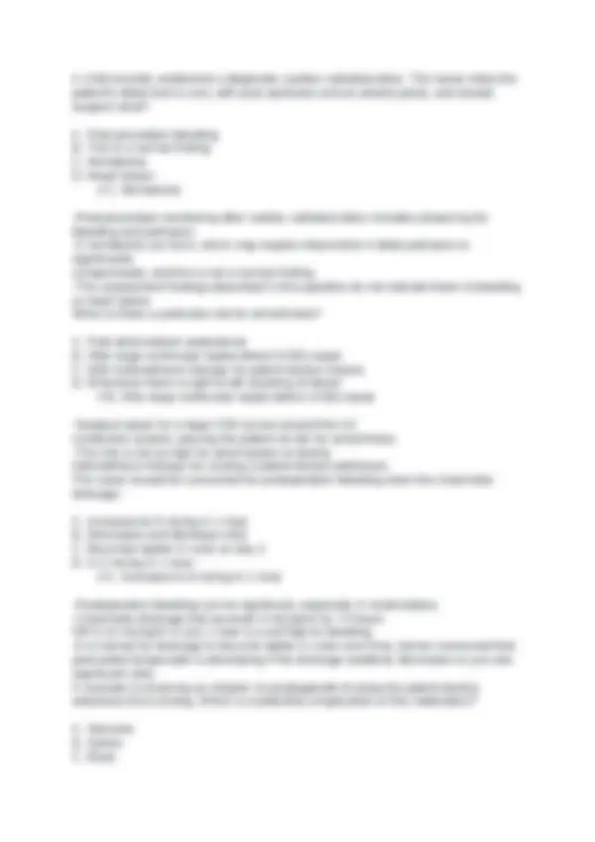
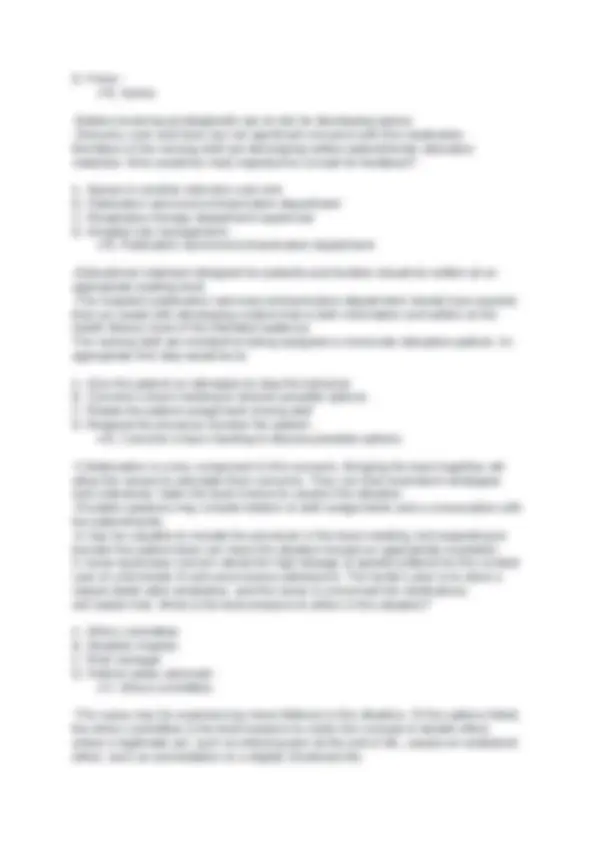
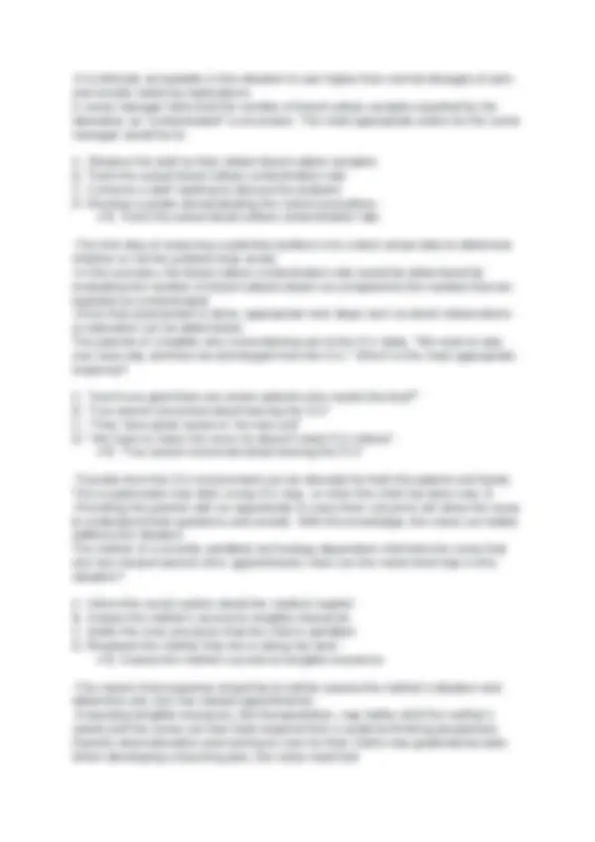
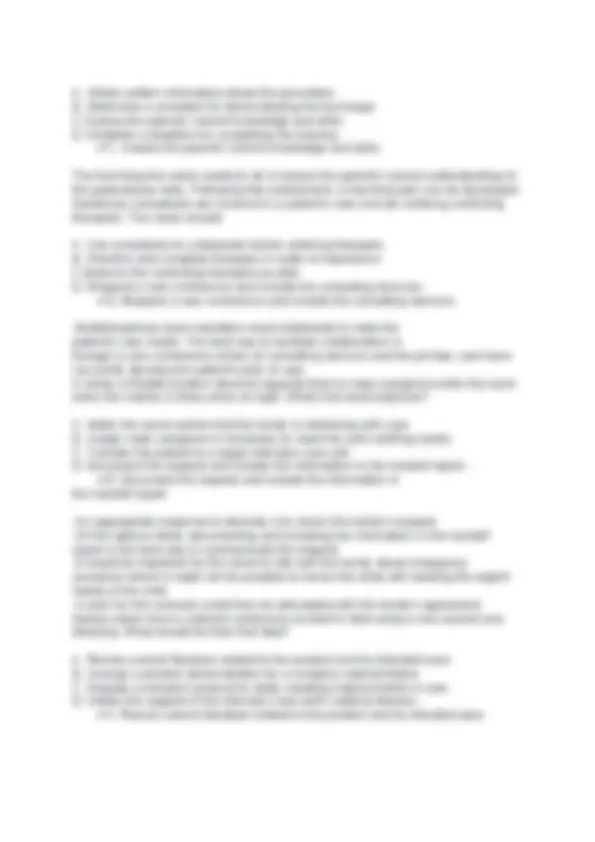
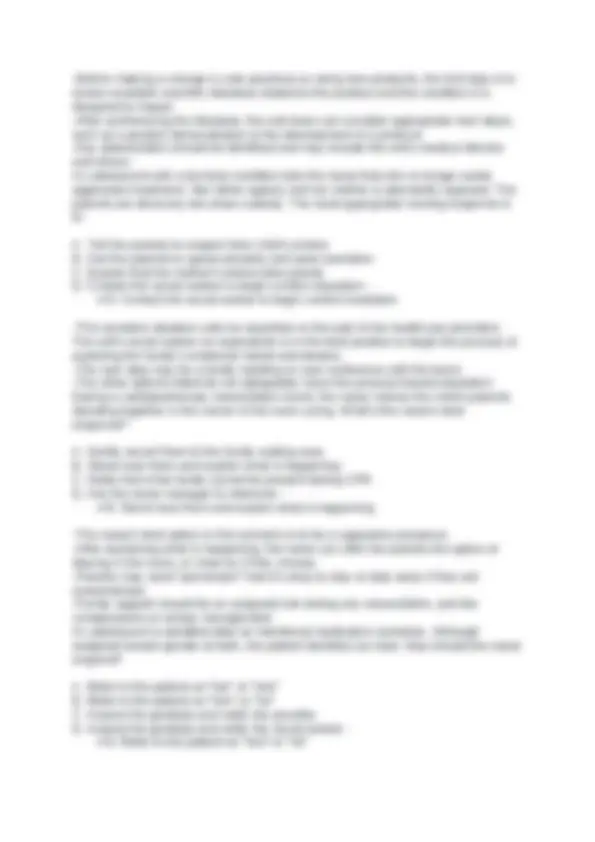
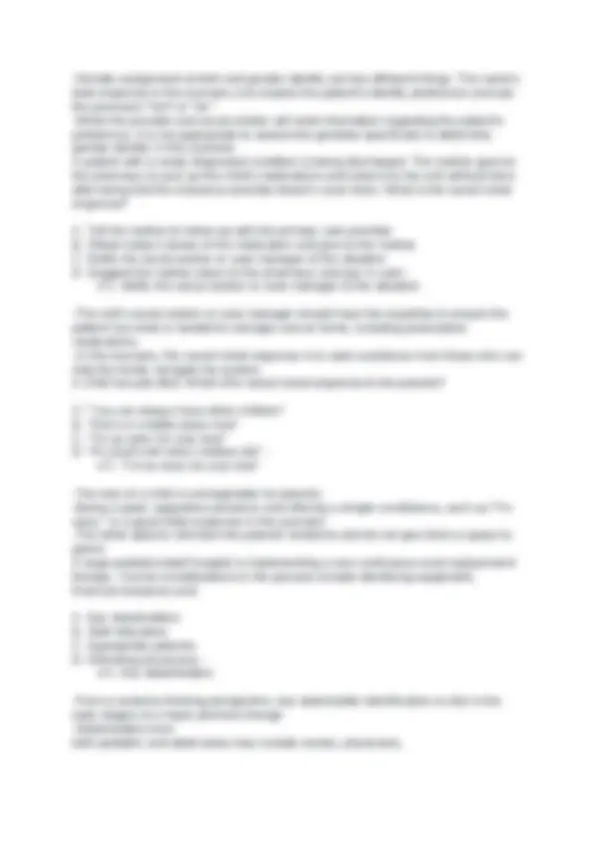



Study with the several resources on Docsity

Earn points by helping other students or get them with a premium plan


Prepare for your exams
Study with the several resources on Docsity

Earn points to download
Earn points by helping other students or get them with a premium plan
Community
Ask the community for help and clear up your study doubts
Discover the best universities in your country according to Docsity users
Free resources
Download our free guides on studying techniques, anxiety management strategies, and thesis advice from Docsity tutors
Insights into various patient conditions in critical care, including weaning from mechanical ventilation, managing respiratory acidosis, and understanding the needs of infants with bpd. It also covers topics like epidural hematoma management, aki, hyponatremia, acute hemolytic reaction, sickle cell disease, tumor lysis syndrome, siadh, pressure injuries prevention, and hemodynamic findings in children. The document emphasizes the importance of assessing patient conditions, implementing appropriate interventions, and tracking data to improve care.
Typology: Exams
1 / 32

This page cannot be seen from the preview
Don't miss anything!

























PEEP is intended to do which of the following? A. Improve ventilation/perfusion matching B. Decrease functional residual capacity C. Increased venous return to the heart D. Increased cardiac output - ✔A. Improve ventilation/perfusion matching
A. Perihilar infiltration B. Hyperinflation C. Foreign body aspiration D. An elevated diaphragm - ✔B. Hyperinflation Remembering that air "trapping" is a common phenomenon in status asthmatics, you would anticipate seeing hyperinflation on this x-ray. A term newborn develops difficulty breathing and cyanosis. The nurse has difficulty hearing breath sounds and notes the baby has a scaphoid abdomen. Which should the nurse suspect? A. Tracheoesophageal fistula B. Diaphragmatic hernia C. Pneumothorax D. Congenital heart defect - ✔B. Diaphragmatic hernia A baby with diaphragmatic hernia will appear to have a scaphoid abdomen because the abdominal contents have shifted up into the thorax. The lungs are hypoplastic and the heart may be shifted to the right. Intubation and positive pressure ventilation are high-risk therapies in the pediatric asthmatic patient due to possible: A. Infection B. Oxygen toxicity C. Pneumothorax D. Ventilator dependence - ✔C. Pneumothorax These patients typically have thick secretions, mucosal edema, and bronchoconstriction, all of which put them at risk for increased airway resistance and air trapping. This, in turn, places them at higher risk for the development of pneumothoraces associated with positive pressure ventilation. A patient with status asthmatics is increasingly somnolent and only able to speak one word between breaths. The priority intervention is: A. Increasing the beta-agonist B. Chest tube placement C. Inhaled nitric oxide D. Intubation - ✔D. Intubation This patient is exhibiting changes in level of consciousness and worsening respiratory distress. The priority intervention at this point is intubation and airway protection. A chest tube may be needed if a pneumothorax develops. The primary objective in the treatment of an infant with pulmonary hypertension is to: A. Maintain the pH level <7.
B. Dilate the pulmonary vascular bed C. Dilate the systemic vascular bed D. Constrict the pulmonary vascular bed - ✔B. Dilate the pulmonary vascular bed Infants with pulmonary hypertension have significantly increased pulmonary vascular resistance. The goal of therapy is to lower the pulmonary vascular resistance through dilation of the pulmonary bed. Patients at risk for pulmonary embolus include those with an inherited hypercoagulable state and: A. Sickle cell disease B. Diabetes C. Asthma D. Pneumonia - ✔A. Sickle cell disease Patients with sickle cell disease are at risk for developing a pulmonary embolus. Sickling of the RBCs within the small blood vessels of the lung and other organs leads to small vessel occlusion and, ultimately, infarction of areas of the pulmonary parenchyma. A baby with BPD will have: A. Left-sided heart failure B. Increased fluid requirements C. Decreased pulmonary vascular resistance D. Increased caloric needs - ✔D. Increased caloric needs -Infants with BPD have increased caloric needs because of the chronic increased work of breathing distress. -They require diuretics and generally do not tolerate fluid overload. -And, they experience increased pulmonary vascular resistance and resultant right-sided heart failure. Cerebrospinal fluid is produced by the: A. Choroid plexus B. Cerebral ventricles C. Arachnoid villi D. Pia mater - ✔A. Choroid plexus Cerebrospinal fluid is formed in the choroid plexus and reabsorbed in the arachnoid villi. Problems with CSF production or absorption can result in hydrocephalus. A child is admitted after falling off a golf cart. The child was initially awake and alert, but now is unresponsive. The nurse should suspect which condition? A. Hydrocephalus B. Epidural hematoma C. Subdural hematoma
Which is the initial independent nursing intervention to maintain cerebral perfusion? A. Hypertonic saline administration B. Maintain head midline C. Initiate blood transfusion D. Administer sedation - ✔B. Maintain head midline -This question asks about the initial independent nursing intervention. -Of the choices offered, maintaining the head midline is the only independent nursing action. This will help to promote venous drainage, which can improve cerebral perfusion. A patient presents with agitation, nuchal rigidity, and a positive Brudzinski sign. The priority intervention is: A. ICP monitoring B. Medical restraints C. Antibiotic administration D. Intraventricular catheter - ✔C. Antibiotic administration -This patient is demonstrating signs of meningitis. Initial treatment includes antibiotic administration. -ICP monitoring and placement of an intraventricular catheter are not indicated in this scenario. -Restraints may be needed, but they could further agitation. A child is admitted to the ICU following a motor vehicle collision in which he was an unrestrained passenger. He is complaining of numbness and tingling in his legs and feet, and has decreased sensation. Preliminary imaging studies are normal. The nurse anticipates: A. Removal of the cervical collar B. Discontinuation of log rolling C. Administration of anti-anxiety medications D. Ongoing spinal cord protective measures - ✔D. Ongoing spinal cord protective measures. -This patient's clinical picture is consistent with spinal cord injury, even though there were no findings on imaging studies. He may have Spinal Cord Injury Without Radiograph Abnormality (SCIWORA). -The patient should have spinal cord protective measures in place (eg, log rolling, cervical collar) at this point. Which is a required element of the exam for brain death determination? A. Apnea test B. EEG C. MRI D. Spinal cord reflexes - ✔A. Apnea test
-Brain death determination requires two exams separated by an observation period based on the child's age. Apnea testing must occur with each exam, unless the patient's condition prevents it. -In that case, an ancillary test such as four-vessel cerebral angiography or EEG is needed. -MRI and testing of spinal cord reflexes are not part of the brain death exam. A patient is admitted with status epilepticus. After arrival, the SpO2 decreases to 85%. The priority response is: A. Oxygen administration B. Anticonvulsant administration C. Intubation D. Bite block insertion - ✔A. Oxygen administration Hypoxia is a complication of seizures, and the therapeutic priority in the management of a seizure is to maintain oxygenation and ventilation. A nasogastric tube should not be inserted in the child with which injury? A. Linear skull fracture B. Basilar skull fracture C. Depressed skull fracture D. Diffuse axonal injury - ✔B. Basilar skull fracture -Nasogastric tubes should not be inserted in patients with suspected basilar skull fractures because the tube could go up through the fracture into the brain. -These patients need an orogastric tube placed through the mouth Interventions for a child experiencing delirium include identifying and treating the underlying cause and: A. Hourly neurologic exams B. Medical restraints C. Benzodiazepine administration D. Sleep promotion - ✔D. Sleep promotion -Children who have delirium often experience sleep disturbances. -Strategies to promote sleep include turning down the lights at night, preventing noise, and allowing the child uninterrupted times for sleeping. -Hourly neurologic exams would not be indicated in this scenario and would interfere with the goal of sleep promotion. -Benzodiazepine administration and medical restraint use can worsen the symptoms of delirium In prerenal AKI, oliguria is the body's compensatory mechanism to: A. Conserve bicarbonate to alter the acid-base balance B. Increase the glomerular filtration rate C. Restore the intravascular volume to increase tissue perfusion
-While each of the interventions listed may be utilized, the intervention choice that will have the most immediate effect is the administration of insulin and glucose. This will help to shift potassium back into the cells and decrease the serum potassium levels. -Additionally, calcium chloride or calcium gluconate should be administered first in order to protect the heart A young child is admitted with hemolytic uremic syndrome. The preferred mode of dialysis in this patient is: A.Peritoneal dialysis B. Hemodialysis C. CVVH D. Dialysis is not indicated - ✔A. Peritoneal dialysis Peritoneal dialysis (PD) is the preferred mode for the patient with HUS. These patients are usually of a younger age, which makes PD a good choice. A recently admitted child has muscle weakness and a tall, peaked T. wave was observed on electrocardiogram. Which intervention do you anticipate? A. Administration of hypertonic saline B. Administration of potassium replacement C. Emergent cardioversion D. Removal of potassium from all IV fluids - ✔D. Removal of potassium from all IV fluids -This patient is demonstrating signs of hyperkalemia. The only option listed that would begin to address this is the removal of potassium from all IV fluids. -Depending on the serum potassium level, the nurse should anticipate administering calcium, insulin/glucose, sodium bicarbonate, and kayexalate. -Hypertonic saline and cardioversion are not indicated and administering potassium in this situation is contraindicated. The nurse is caring for a child with liver failure and who is experiencing profound abdominal distention. What is the primary concern? A. Renal insufficiency B. Biliary atresia C. Intestinal perforation D. Respiratory failure - ✔D. Respiratory failure -Children with liver failure can experience profound abdominal ascites and distention. This process pushes up on the diaphragm and can result in respiratory distress, which can lead to respiratory failure. -Increased pressure in the abdomen can compromise perfusion to other abdominal organs, like the kidney. But in this scenario, respiratory distress is the primary concern.
The nurse caring for a child who was injured in a motor vehicle crash notes positive Cullen's sign in the right abdomen around the umbilicus. This is indicative of: A. Impending disseminated intravascular coagulopathy B. Necrotic bowel process C. Sepsis D. Intra-abdominal bleeding - ✔D. Intra-abdominal bleeding In cases of severe intra-abdominal bleeding, Cullen's sign (bluish discoloration around the periumbilical area) may be seen. The nurse should be concerned that the child has severe injuries and may need surgical exploration or repair. The primary concern for a child diagnosed with intussusception is: A. Dehydration B. Bowel infarction C. Infection D. Pain - ✔B. Bowel infarction -When intussusception occurs, part of the bowel telescopes inside itself. This can result in decreased arterial blood flow to the area and resultant bowel infarction. -Intervention to correct the telescoping bowel needs to be initiated immediately. -The child may experience severe paroxysmal pain, is at risk for dehydration, and can develop an infection if perforation occurs. You are caring for an adolescent with multiple traumatic injuries sustained in a motor vehicle collision. Upon assessment, you notice that the patient has developed shallow, rapid respirations and abdominal distention; is now complaining of pain in the area of the right shoulder; and whose BP has also dropped to 80/50 mmHg. You suspect that this patient has sustained a traumatic injury to the: A. Spleen B. Liver C. Kidneys D. Clavicle - ✔B. Liver Abdominal distention and rapid, shallow respirations may be seen with many abdominal injuries. -Pain that radiates to the right shoulder is consistent with hepatic injury. -Additionally, the patient is showing signs of shock, which can be associated with bleeding from a lacerated liver. Which would be an indication for urgent surgical intervention in the child with a gastrointestinal hemorrhage? A. Presence of free air on abdominal radiograph B. Weakness and faintness
ABO-incompatible blood, resulting in hemolysis of the red cells. The first intervention to manage your patient's acute hemolytic reaction should be to: A. Notify the physician B. Treat shock and/or respiratory distress C.Stop the transfusion D. Keep vein open with an infusion of 0.9% NaCl - ✔C. Stop the transfusion Each intervention is important, but the first intervention must be to stop the transfusion if you suspect that your patient is having an acute hemolytic reaction. Which electrolyte disturbances would you monitor for in the patient who is receiving multiple, large-volume blood transfusions? A. Hypernatremia and hyperphosphatemia B. Hypocalcemia and hypophosphatemia C. Hyperkalemia and hyponatremia D. Hypocalcemia and hyperkalemia - ✔D. Hypocalcemia and hyperkalemia -Patients who receive large-volume blood transfusions must be monitored for the development of hypocalcemia and hyperkalemia. -The hypocalcemia is the result of calcium binding to the citrate used as a preservative in the blood -The hyperkalemia is typically associated with the breakdown of cells in "older" blood. Which should be avoided in the patient with sickle cell disease? A. Opioids B. Oxygen C. Dehydration D. Normothermia - ✔C. Dehydration Management strategies for the patient with sickle cell disease include providing hydration, oxygenation, pain control, and antibiotics if infection is a suspected cause The triad of metabolic disturbances most frequently seen with tumor lysis syndrome is: A. Hypophosphatemia, hyperkalemia, hypercalcemia B. Hyperphosphatemia, hyperkalemia, hyperuricemia C. Hyperphosphatemia, hyperuricemia, hypocalcemia D. Hypophosphatemia, hypokalemia, hypocalcemia - ✔B. Hyperphosphatemia, hyperkalemia, hyperuricemia -Tumor cells have a higher concentration of potassium and phosphorous than normal cells do. -The hyperuricemia is from the breakdown of nucleic acids in tumor cells. -The hypocalcemia that occurs is secondary to the hyperphosphatemia.
Strategies for managing tumor lysis syndrome include increasing: A. Oral potassium intake B. Hydration C. Intravenous phosphate intake D. Uric acid production - ✔B. Hydration -The purpose of hydration is to maximize renal excretion of potassium, phosphate, and uric acid. -It would be contraindicated to administer potassium or phosphate to this patient. -An additional goal is to decrease the uric acid level, not increase production. A toddler was extubated 2 days ago after 10 days of mechanical ventilation for viral bronchiolitis. With your initial assessment, you note bleeding from the patient's nares and two large bruises on the chest, with petechiae on all extremities. Lab results demonstrate a normal PT/PTT and D-dimer, but the platelet count is significantly decreased. What do you suspect? A. Disseminated intravascular coagulopathy B. Thrombotic thrombocytopenic purpura C. Idiopathic thrombocytopenic purpura D. Hemolytic uremic syndrome - ✔C. Idiopathic thrombocytopenic purpura -ITP is an immune-mediated decrease in platelet count. -It often occurs following a viral infection. -Diagnostic studies will reveal a low platelet count, but normal PT/PTT and D-dimer. A child having a seizure has a serum sodium level of 125 mEq/L and a decreased urine output. What disease process is most likely? A. Diabetes mellitus (DM) B. Syndrome of inappropriate antidiuretic hormone (SIADH) C. Diabetes insipidus (DI) D. Diabetic ketoacidosis (DKA) - ✔B. Syndrome of inappropriate antidiuretic hormone (SIADH) -The symptoms of SIADH include hyponatremia and decreased urine output. -The child is likely having a seizure because of the low serum sodium. -A child with DI would have an increased serum sodium level and a significantly increased urine output. -Diabetes mellitus and DKA are disorders of glucose control. Which parameters signal the development of SIADH? A. Decreased serum sodium, decreased serum osmolality B. Increased serum sodium, increased serum osmolality C. Decreased serum sodium, increased serum osmolality D. Increased serum sodium, decreased serum osmolality - ✔A. Decreased serum sodium; decreased serum osmolality
✔B. Vasopressin and urine output replacement -Immediate treatment for a patient with symptomatic DI is ADH replacement and urine output replacement to keep the patient from progressing to profound hypovolemic shock. -Hypotonic fluids and hypertonic saline administration are contraindicated in this situation. -Fluid restriction to 75% of maintenance needs is a treatment for SIADH. Which of the following actions would be appropriate after the administration of Desmopressin (DDAVP) to a patient with DI? A. Decreasing fluids B. Increasing fluids C. Increasing sodium intake D. Decreasing sodium intake - ✔A. Decreasing fluids -Administration of DDAVP should result in renal retention of water and a subsequent increase in intravascular volume. -If those things occur, the nurse could anticipate that intravenous fluids would be decreased. A child being treated for DKA becomes more lethargic, is difficult to arouse, and has vomited twice in the past hour. These symptoms could be interpreted as indications of: A. Exhaustion due to lack of sleep B. The development of hypoglycemia C. Decreased intestinal motility D. Cerebral edema and increased ICP - ✔D. Cerebral edema and increased ICP -These symptoms are indications that the child may be developing cerebral edema and an increased ICP. -Nurses must recognize that children with DKA are at a higher risk for the development of cerebral edema and must monitor closely for any changes in neurological status. A child in DKA has a glucose of 350 mg/dL. One hour later the glucose is 250 mg/dL. The nurse would anticipate the administration of: A. Potassium chloride B. Sodium bicarbonate C. Dextrose solution D. Subcutaneous insulin - ✔C. Dextrose solution -As the glucose decreases to 250 mg/dL, it will become necessary to administer glucose in addition to the insulin infusion that this patient is likely already receiving. -The child in DKA will not receive SQ insulin, as she will not be able to utilize that as effectively as IV insulin.
-You have no information to suggest that this patient requires electrolyte supplementation. -Sodium bicarbonate is not appropriate An adolescent is admitted with an unstable pelvic fracture. The nurse should anticipate the patient may need which intervention because of this injury? A. Frequent pupillary assessment B. Incentive spirometry C. Long-bone casting D. Leg-length monitoring - ✔B. Incentive spirometry -Patients with unstable pelvic fractures are likely to need prolonged bedrest and are at risk for atelectasis; thus, meticulous pulmonary toilet is important, which includes incentive spirometry. -Other nursing interventions include neurovascular monitoring of the distal extremities and measures to prevent skin breakdown. What is the priority intervention for compartment syndrome? A. Neurovascular monitoring B. Elevating the extremity C. Fasciotomy D. Pain management - ✔C. Fasciotomy -The priority intervention to relieve the effects of compartment syndrome and prevent further damage is a fasciotomy. -It is important to continue neurovascular monitoring and ensure the child receives adequate pain management. The nurse should be concerned for which electrolyte imbalance after a fasciotomy is performed to manage compartment syndrome? A. Hyperkalemia B. Hypernatremia C. Hypophosphatemia D. Hypercalcemia - ✔A. Hyperkalemia -The child who requires a fasciotomy for compartment syndrome is at risk for rhabdomyolysis after the damaged skeletal muscle cells release myoglobin, potassium, phosphate, and lactate into the circulation. -The result is hyperkalemia, hypocalcemia, hyperphosphatemia, and acidosis. Which is a risk factor for the development of a pressure injury? A. Adequate nutrition B. Hyperperfusion
A. Consult with the team about adjusting the ventilator settings B. Place a rectal probe and begin external cooling C. Start an epinephrine infusion D. Repeat a fluid bolus of 20 mL/kg - ✔D. Repeat a fluid bolus of 20 mL/kg -Children with septic shock typically have very large fluid deficits. -Most children require at least 40-60 mL/kg, but some may require as much as 200 mL/kg. -There is no indication that ventilator settings need to be adjusted. -The other two interventions (epinephrine and cooling) may be indicated, as well, but fluid resuscitation is the first priority. Lactic acid production occurs when there is: A. Improved cellular function B. Anaerobic metabolism C. Alteration in body temperature D. Aerobic metabolism - ✔B. Anaerobic metabolism -As shock progresses to an uncompensated state, metabolism shifts from aerobic to anaerobic, resulting in increased production of lactic acid. The following blood gas results are consistent with which condition? pH 7. PaC02 61 mmHg Pa02 58 mmHg HCO3 24 mmHg A. Respiratory acidosis B. Respiratory alkalosis C. Metabolic acidosis D. Metabolic alkalosis - ✔A. Respiratory acidosis This blood gas result reveals a low pH, elevated CO2, low 02, and normal HCO3. We would expect to see a child with this blood gas in respiratory distress. A 4-month-old arrives with a 24-hour history of vomiting and diarrhea. The patient is lethargic, pale, cool, and clammy. Weak peripheral pulses can be palpated and her capillary refill time is >4 seconds. The child is in: A. Hypovolemic shock B. Septic shock C. Anaphylactic shock D. Cardiogenic shock - ✔A. Hypovolemic shock -This patient's history and clinical exam are consistent with hypovolemic shock.
-Gastroenteritis is a common cause of fluid loss in an infant, which can result in significant hypovolemia. The child is placed on high-flow oxygen and an IV is inserted. An initial fluid bolus is ordered. The child weighs 7 kg. Which of the following is the most appropriate fluid to administer to this infant? A. D1OW B. 0.9% normal saline C. Packed red blood cells D. Hypertonic saline - ✔B. 0.9% normal saline -The initial fluid bolus for a child in hypovolemic shock from gastroenteritis should be an isotonic crystalloid solution, usually 0.9% normal saline. -D10W contains glucose and is not isotonic; therefore, it should not be used as a fluid bolus. -Packed red blood cells and hypertonic saline are not indicated in this patient scenario. The parents of a 15-month-old state that she has a high fever and vomiting and is now extremely irritable. The mother states there are "bruises" and a spotty rash on the child's legs, but she has no history of recent trauma. The child's vital signs are HR 160, RR 38, BP 74/52, and rectal temperature of 41°C. This child is most likely experiencing: A. Hypovolemic shock B. Cardiogenic shock C. Septic shock D. Anaphylactic shock. - ✔C. Septic shock -The child's history and clinical presentation are suggestive of sepsis and septic shock. She quickly needs an IV fluid bolus and antibiotics An adolescent intentionally ingested acetaminophen and has a toxic level. In addition to fluid hydration, the patient should receive: A. Hemodialysis B. N-acetylcysteine C. Sodium bicarbonate D. Ipecac syrup - ✔B. N-acetylcysteine -The antidote for acetaminophen ingestion is N-acetylcysteine, given as an intravenous infusion. -Hemodialysis and sodium bicarbonate are not indicated in this scenario, but might be appropriate for salicylate overdose. -Ipecac syrup is not recommended. -This child may also benefit from psychosocial support and mental health care A toddler is hospitalized after ingesting her older sister's clonidine. Which is an essential intervention to prevent future occurrences?